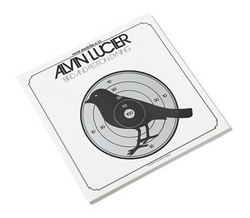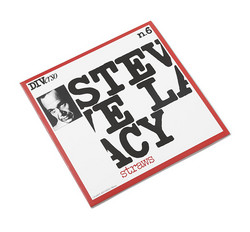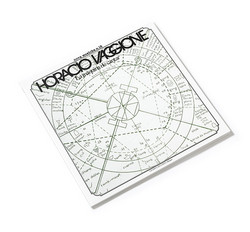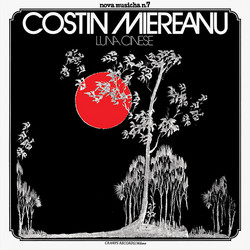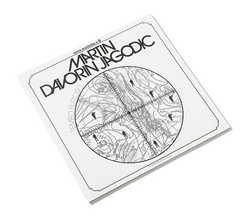Cramps Records Reissues by Dialogo
Of all the historic labels associated with experimental music, few have been as important as the Italian imprint Cramps. Relatively short lived, running for only seven years, its catalog reads like a who’s who of the 1970s musical avant-garde, housing seminal albums by John Cage, Gruppo di Improvvisazione Nuova Consonanza, Giusto Pio, Demetrio Stratos, Juan Hidalgo, Robert Ashley, Walter Marchetti, Cornelius Cardew, Raul Lovisoni / Francesco Messina, Derek Bailey, and numerous other luminary figures. With the vast majority of these albums having remained largely out of print and nearly impossible to obtain for decades, recently the Milan based imprint, Dialogo, started a stunning series of vinyl reissues of the Cramps catalogue. So far they have unleashed six LPs, all of them standing among the most singular and important experimental albums of the 1970s: Alvin Lucier's Bird and Person Dyning, David Tudor’s Microphone, Steve Lacy’s Straws, Horacio Vaggione’s La Maquina de Cantar, Costin Miereanu's Luna Cinese and Martin Davorin Jagodić's Tempo Furioso (Tolles Wetter). Engrossing, creatively riveting, and as ahead of their time today as they were upon their initial release, they are just about as exciting as reissues come.

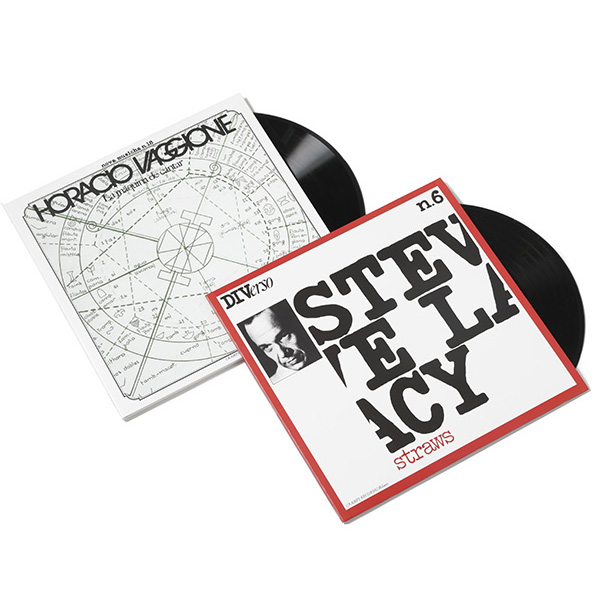

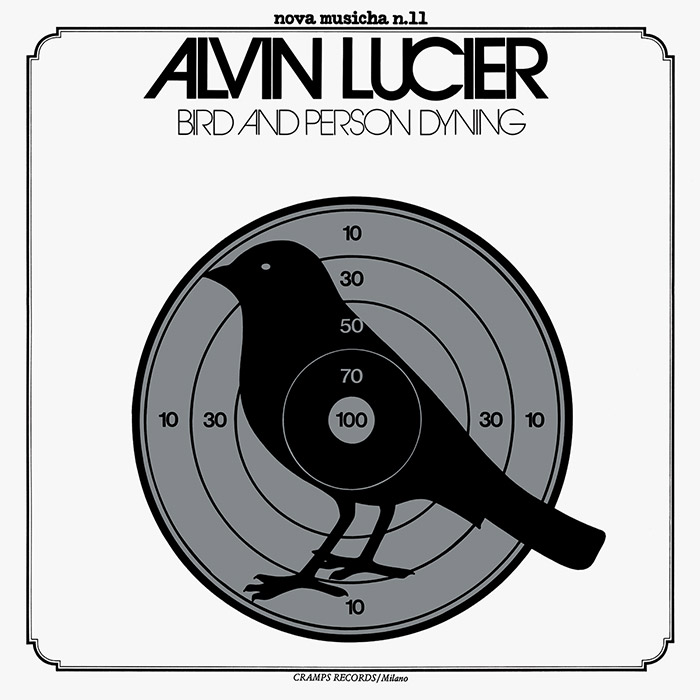
Alvin Lucier "Bird and Person Dyning" (LP, 1976)
Of all the historic labels associated with experimental music, few have been as important as the Italian imprint Cramps. Relatively short lived, running for only seven years, its catalog reads like a who’s who of the 1970s musical avant-garde, housing seminal albums by John Cage, Gruppo di Improvvisazione Nuova Consonanza, Giusto Pio, Demetrio Stratos, Juan Hidalgo, Robert Ashley, Walter Marchetti, Cornelius Cardew, Raul Lovisoni / Francesco Messina, Derek Bailey, and numerous other luminary figures. With the vast majority of these albums having remained largely out of print and nearly impossible to obtain for decades, recently the Milan based imprint, Dialogo, announced a stunning series of vinyl reissues of the Cramps catalogue. They hit the ground running and have already brought us reissues of David Tudor’s Microphone, Horacio Vaggione’s La Maquina de Cantar, Steve Lacy’s Straws, and Costin Miereanu's Luna Cinese. Now they are back with yet another, the long-awaited reissue of Alvin Lucier’s seminal work, Bird and Person Dyning, issued by Cramps in 1976 as the 11th instalment of their Nova Musicha series. Easily one of the most important works in the entire canon of 20th Century experimental music and out of print for decades, this is a truly historic event. Issued by Dialogo in a limited edition of 300 copies on black vinyl, with fully remastered audio, housed in a gatefold sleeve that beautifully reproduces the original design, complete with brand new English translations of the original liner notes, those who want it better move fast. This one is going to fly.
Born in 1931 and active for roughly three quarters of a century, Alvin Lucier is a living legend and a treasure of the American musical avant-garde. It is impossible to overstate his importance. He is a towering pilar of intellect, creativity, and beauty who has yielded unparalleled influence with a body of work that has plumbed the depths of acoustic phenomena and auditory perception, exploring the resonance of spaces, phase interference between closely tuned pitches, and the transmission of sound through physical media, rising with unparalleled subtly innovation, and poetic depth.
Lucier belongs to a generation of composers who emerged during the early 1960’s, inheriting, but not beholden to, a landscape in constant creative and conceptual flux, contending with the challenges put forth by predecessors like John Cage. With David Behrman, Gordon Mumma and Robert Ashley, he founded the legendary collective the Sonic Arts Union in 1966, all the while sculpting a singular and unparalleled body of work, focused around acoustic phenomena and auditory perception, which included, among many others, the groundbreaking works like Music on a Long Thin Wire and I Am Sitting in a Room, each quietly shifting the understanding of what music could be. Among these earlier efforts, his first solo LP, Bird and Person Dyning, issued by Cramps in 1976, stands high among the most groundbreaking and important.
Bird and Person Dyning comprised two incredible pieces from this phase in Lucier’s career, The Duke of York and the title track, each taking up a single side of the LP. The first, The Duke of York, is built around the human voice and drew its early inspiration from Lucier’s dream to build a grotesque jukebox to create a real-time collage of the cultural imprints of popular sound.
In the composer’s own words, “A single performer chooses and determines the order of an indefinite number of whole songs, speeches, arias, selected excerpts from books, letters, poems, films, plays, TV series or any other vocal sounds, including non-human ones. The actual duration of these sounds is altered by one or more people using synthesisers or other electronic tools, basing their choices on memories or similar experiences. Once altered, for example through a filter, the example can no longer be undone, and other changes must be made to the previous examples.” The final effect, as it evolves over the duration of the piece, is a stunning collision of vocal fragments, almost seeming to swim against the increasing tide of synthetic intervention and electronic sound, slowly becoming subsumed and transformed in a raw, unrecognizable materiality itself.
Bird and Person Dyning, taking up the second side, is a groundbreaking work that lays important foundations for Lucier’s life long exploration of sound in space, its relation to the body, and the generative possibilities of close pitches, in this case exploring the sounds of an electronic bird as they resonate inside of the head and in the ear canals.
As he describes it in the album’s liner notes, “I began experimenting by moving the sounds of the bird between two speakers, listening to them through the two mini microphones inserted in my ears, as I walked slowly through the space between the two speakers. The amplified chirps moved left and right according to my movements, creating small time delays and phase-shifts in relation to the position of the motionless bird. Sometimes the microphones would resonate with the loudspeakers, thus generating a Larsen feedback, and I could control the timbre and volume with small head movements [...]. A performance of Bird and Person Dyning is a live exploration of these phenomena.”
The outcome is unlike anything in the history of recorded music prior to it, a tense effort of minimal materiality that maximizes its possibilities to monumental terms, shifting and spatializing tones and electronic sounds producing a previously unencountered world.
As important as reissues come, the seminal document from early in Lucier’s career is released by Dialogo in a limited edition of 300 copies on black vinyl, with fully remastered audio, housed in a gatefold sleeve that beautifully reproduces the original design, complete with brand new English translations of the original liner notes.
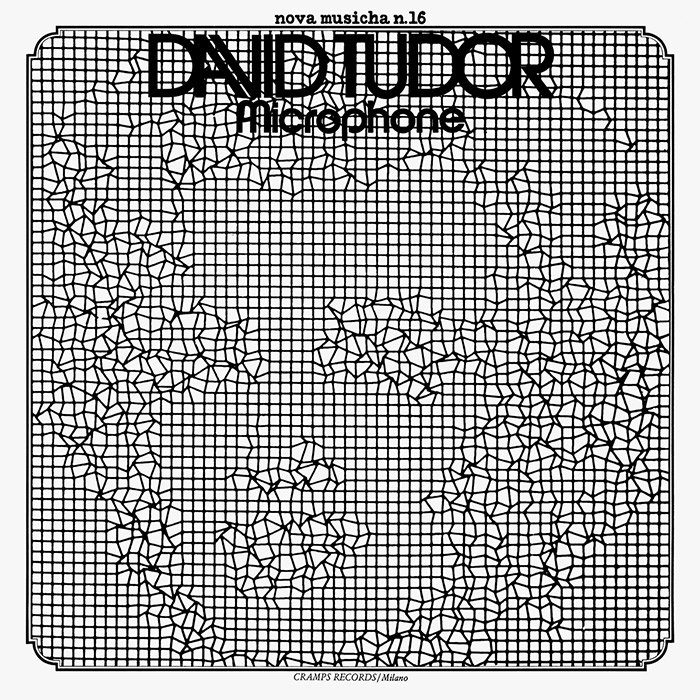
David Tudor "Microphone" (LP, 1978)
Among the most beloved and sought-after albums released by Cramps - now finally reissued on vinyl by Dialogo - was the American composer and pianist David Tudor's Microphone, originally issued in 1978.
Arguably the most important interpreter of experimental music during the 1950s and '60s - shooting to fame as a result of his early performances of works by Pierre Boulez, Karlheinz Stockhausen, Morton Feldman, Earle Brown, Christian Wolff and La Monte Young, David Tudor remains most famous for his long-lasting working relationship with John Cage. To this day, the power and importance of these collaborations casts a long shadow over his own work as a composer, despite it becoming the central axis of role in his creative output, beginning in the early 1960s.
David Tudor's own compositions almost entirely rest in the electronic realm, deploying modular devices - largely designed and built by himself - which were allowed to define both composition and performance. Building upon the innovations of Rainforest - a multimedia work that began to emerge in variations during the late '60s and early '70s - among the most important and famous of Tudor efforts as a composer is Microphone, which became his first recorded appearance as a solo composer, when the album was issued by Cramps in 1978.
Microphone utilizes a single sound-source, the modulation of microphone feedback produced in a distant echo chamber, sculpted in incidence and duration by narrow band filters, with numerous versions recorded simultaneously, before being spliced onto two channels, using a pan-matrix. The end result became a library of 9 stereo tapes - recorded at Mills College during 1973 - each about 32 min. long, that were used in any combination - played and stopped at any point, rewound and played again, altered in amplitude and/or equalization - during live performances or for electronic installations.
The version of Microphone that appears on this LP captures its realization in 1973 at the Pepsi Pavilion of Expo '70, in Osaka, Japan, and derives from discoveries made through the composer's collaboration in the design of the Pavilion's acoustic system, which used 37 loudspeakers placed in a rhomboid grid system covering 3/4 of the sphere.
Clocking in at nearly an hour in length, once heard, Microphone rapidly emerges as one of the most striking and important works of 1970s electronic composition. Restrained and defined by exacting control on the part of the composer / performer, deep tonalities of varying durations and textures pulse with a chasmic void, as though emerging, fulling formed from a dark unknown. Time slows in unexpected and destabilizing ways, weaving a spectrum of sound from the wholly synthetic that feels strikingly connected to the organic world.
A work that leaves you on the edge of your seat from start to finish, Microphone brings the towering importance of David Tudor's work as a composer into full focus, nearly 50 years after it was first laid to tape. Absolutely stunning and just as thrilling and ahead of its time today as it was then, it's impossible to express how excited we are to have Dialogo's long overdue vinyl reissue finally in our hands. As essential as any reissue comes, and not to be missed on any count.
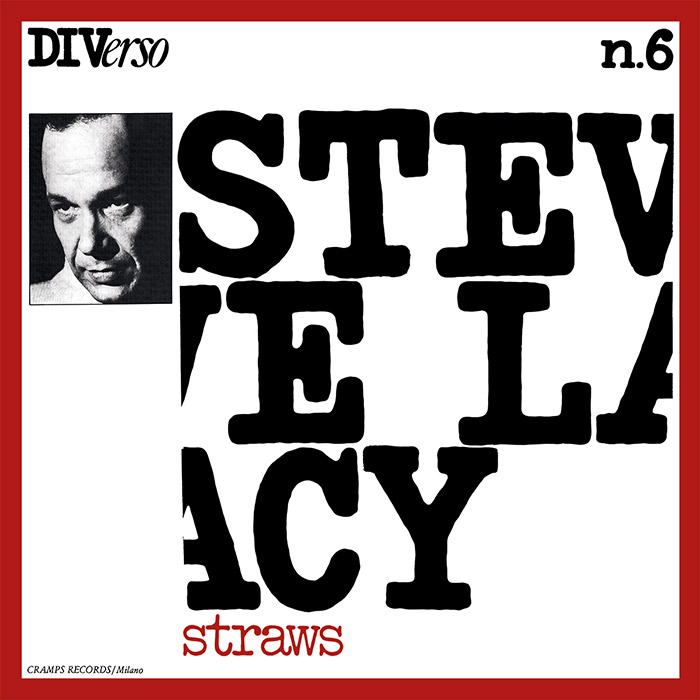
Steve Lacy "Straws" (LP, 1977)
First emerging during the mid 1950s, saxophonist and composer, Steve Lacy (1934 – 2004), has long been regarded as one of the most important contributors to 20th Century musical canon, producing groundbreaking records with Cecil Taylor, Don Cherry, Thelonious Monk, Kenny Burrell, The Jazz Composer's Orchestra, Alan Silva, Roswell Rudd, Globe Unity Orchestra, ICP Orchestra, Miles Davis, and numerous others. An early adopter of free improvisation and experimental forms of jazz, despite his incredible catalog of collaborations, it is Lacy’s work as a solo artist and band leader that towers above the rest.
Released in 1977, Straws encounters Lacy more than two decades into his professional career, brimming with confidence, versatility, and at the top of his game, building on the back of an incredibly prolific period of recording that grew from his move to Paris in 1970, where he remained for the bulk of his remaining years. The album, sparse and visionary, features six individual works - two solo pieces, two with celeste accompaniment, and two tape collages - dedicated to figures from various disciples of the arts, Brion Gysin, Janis Joplin, Art Tatum, Marilyn Monroe, Igor Stravinsky, and his wife, the singer Irene Aebi.
Easily among the most adventurous of Lacy’s output from the period, Straws deftly rises to the demands of each challenging venture, creating something entirely brave, singular and visionary from clusters of tone, airy spaces, deconstructed melodic structures, playful moments, and truly radical dialogs with himself.
Freejazz that’s not quit freejazz, and experimental music as it should be understood and rarely is, Straws, heard more than fourty years after it first emerged, heaves with life, and stands as a potent reminder of what a powerful creative voice Lacy was. It’s absolutely incredible and engrossing from the first note to the last. This first-time vinyl reissue from Dialogo comes in a beautifully produced sleeve that faithful reproduces the original cover artwork and inner sleeve. A must for fans of Cramps, Lacy, or experimental music and freejazz at large.
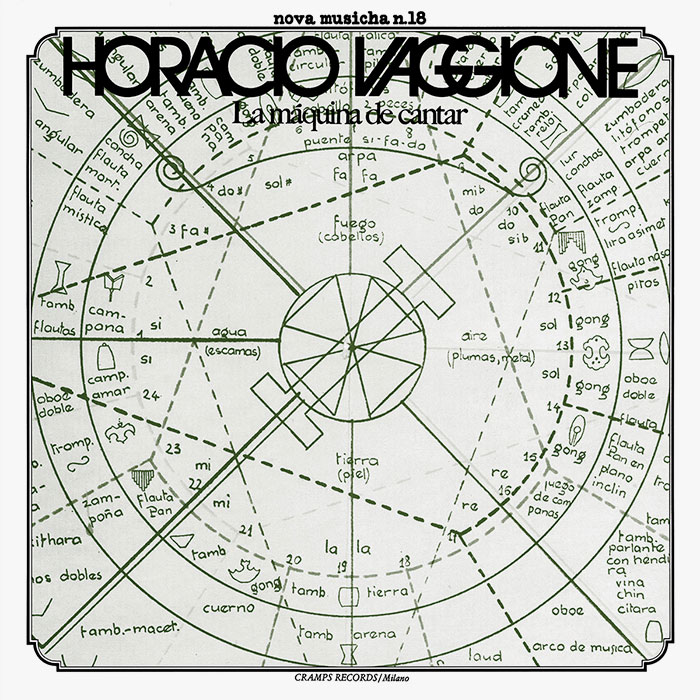
Horacio Vaggione "La Maquina de Cantar" (LP, 1978)
Horacio Vaggione belongs to a fascinating, and all-too-often overlooked history of Latin American avant-garde and experimental composers that emerged during the post-war period. This movement, which swept across numerous countries in the region, is among the most important canons of sonic material from the 20th Century - as radical as it was visionary - but has been tragically cast from view, beneath the shadow of decades of authoritarian governmental rule - most often in the form of military juntas - that suppressed its output and place in the larger global scene.
Born in Argentina in 1943, in 1965 Vaggione helped found the Experimental Music Center of the University of Cordoba - one of a number of important, early electronic music studios in Latin America - before departing to Europe in 1969, first to Madrid, and then to Paris in 1978, where he has lived ever since. His work is largely focused around micromontage, granular synthesis, and microsound, working with acoustic instrumentation, synthesis, and computer-based platforms. Recorded in 1971 and released in 1978, his debut LP, La Maquina de Cantar, was the 18th instalment of Cramp’s Nova Musicha series, and a truly astounding piece of work that was arguably decades ahead of its time.
La Maquina de Cantar, a work that extends across the full first side of the LP, was created using the IBM 7090 computer at the University of Madrid, deploying a hybrid form of sound synthesis, using both digital and analogue operations. Having written the score in standard musical notation, the notes were then transcribed into decimal numerical notation, which was then written into the machine’s language, in the form of punch cards, which allowed the computer the means to generate sound. This digital production was then run through an analogue section, consisting of a series of filters, a voltage-controlled oscillator, and an echo chamber. The result is a visionary work of minimalism, the likes of which had never been seen at the time of its composing, defined by shimmering layers of arpeggiating notes - slowly evolving in pitch, density, and speed - that cascade with unrelenting energy and textural presence across 17 minutes of sublime beauty.
The album’s second side is taken up by the work Ending, dedicated to the composer Robert Ashley, which was created during roughly the same period for live electronic keyboards: three Minimoog synthesizers played by the composer, and a Yamaha organ played by Elizabeth Wiener. Working as a perfect counterpoint to its predecessor, cycling repetitions of hypnotic tones pulse and dance as the dialog between the two players unfolds, splashing sci-fi images of a world that has still yet to come to be.
An inevitable revelation for anyone yet to encounter it, La Maquina de Cantar is easily among the most beautiful and important reissues of the year. 1970s Minimalism as it’s rarely been heard, and truly stunning on every count. This first-time vinyl reissue from Dialogo comes in a beautifully produced sleeve that faithful reproduces the original cover artwork and inner sleeve, and includes a brand-new English translation of the original liner notes, offering crucial insight into the creation of these works.
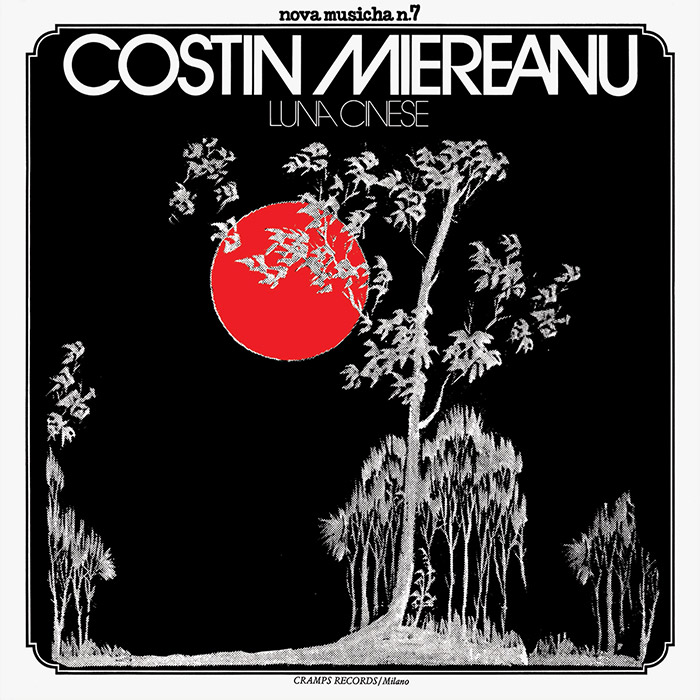
Costin Miereanu "Luna Cinese" (LP, 1975)
Of all the seminal figures that recorded for Cramps, the Romanian / French composer, Costin Miereanu, remains among the most distinct and under-appreciated. The reemergence of his debut LP, Luna Cinese, issued by the label in 1975, will likely change that.
Over the last decade or so, Miereanu has developed something of a cult following among experimental fans because of his stunning series of albums issued during the 1980s on his own Poly-Art imprint, skirting the border of ambient music and minimalism in highly individual ways. Luna Cinese, which dives into far more explicitly experimental territory, will undoubtedly be a revelation and expose the true underpinnings of the work that would begin to emerge of the next decade and a half.
During his early years, Costin Miereanu was something of a wunderkind of avant-garde and experimental music. Born in Bucharest, between 1960 to 1966 he was a student of Alfred Mendelsohn, Dan Constantinescu, and Lazar Octavian Cosma, before moving to Paris where he earned a Doctor of Letters and a Doctor of Musical Semiotics, winning numerous prizes in writing, analysis, music history, esthetics, orchestration, and composition. Between 1967 and 1969 he was a student of Karlheinz Stockhausen, György Ligeti, and Ehrhard Karkoschka at the Internationale Ferienkurse für neue Musik in Darmstadt, laying the final groundwork for a stunning career as both a composer and noted academic over the years since, often combining techniques drawn from Satie with the abstraction of Romanian traditional music into a sonic fabric that is guided by systems associated with Musique concrète.
Luna Cinese, issued as the composer's debut LP by Cramps in 1975, is a stunning combination of all these elements. The work - stretching across the album's two sides, consists of continuous low-density repetitions, build from what the composer describes as “the kind of 'woven' silence you find on mountains – occasionally disturbed by irregular and very dense insertions – the kind of intense noise you find in the city.” The result, combining a vast range of environmental sound, voices chattering in various languages, fragments of acoustic instrumentation, and the pulsing and ambiences of synths and electronics, is about as singular and beautiful as experimental works from the 1970s come, while never for a moment sacrificing rigour or tension.
A truly stunning, interwoven sonic expanse that lays pregnant with multiple meaning and interpretations - conceived by the composer to illuminate the complex ways in which meaning and narrative are constructed across time - and imbued with surrealism and the 'schizoid', Luna Cinese stands as an entirely distinct and original gesture within the canon of experimental music, displaying a remarkable density, while open, airy, and encouraging the subjectivity of the listener to play an active part.
Easily among the best and important works from the original Cramps catalog, but sinfully overlook over the years since its release, Luna Cinese is as good as they come and an absolutely riveting and immersive listen. Issued by Dialogo in this newly remastered vinyl edition - the first since 1975 - with its original liner notes by Miereanu in a brand-new English translation, this one is impossible to recommend enough and will leave the composer ringing in your mind for a long time to come.
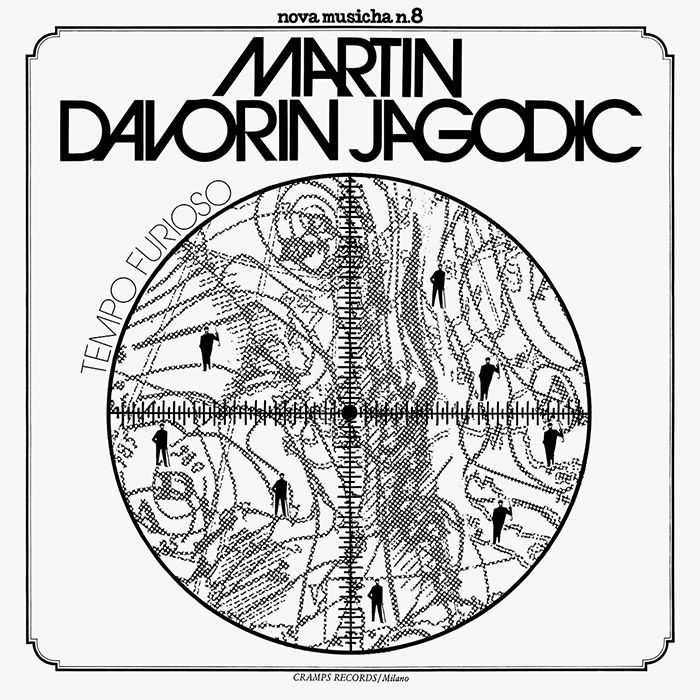
Martin Davorin Jagodić "Tempo Furioso" (LP, 1975)
Martin Davorin Jagodić (1935 – 2020) was a Croatian composer and educator, who studied under Milko Kelemen, among others, before relocating to France in 1960 to study under Olivier Messiaen, eventually landing at Groupe de Recherches Musicales, where he worked between 1967 to 1969. Over his long career, he collaborated with John Cage and various painters and film makers, and composed for theatre, multimedia installation art, experimental film soundtracks, radio art, electroacoustic music, musique concrète - often incorporating video, film and slide projections into his performances - but sadly only produced one album, Tempo Furioso (Tolles Wetter), issued in 1975 by Cramps as the 8th instalment of the their Nova Musicha series.
Tempo Furioso (Tolles Wetter) is an electroacoustic work that incorporates elements of radical approaches to electronics and musique concrète, including found sounds into its two long movements (one for each side of the LP). In his liner notes for the original edition - now translated into English for the first time by Dialogo - Davorin Jagodić likens the work, one of many possible manifestations of its open structures - to a storm unsettling a listener who resides in the safety and warmth of their home; the infiltration of naturally encountered sonorities demanding to be heard - “wood creaking, wind blowing, as well as lines connecting us with the outside world, far away as it might be (radio stations, for instance).”
Launching with marked intensity, across its early moments Tempo Furioso (Tolles Wetter) immerses the listener within an intricate tapestry of far-out electronic sounds, before gradually moving toward an incredibly complex and diverse pallet of found sounds, incorporating field recordings and broadcast sounds - static, speech, and numerous fragments of music - that intersect and collide like a transnational radio placed in various environments and spun out of control, culminating the first side with a cacophony built around an unknown document of free jazz.
By contrast, the second movement of Tempo Furioso (Tolles Wetter) is no less 'musical' but defined by large passages of intricate, restrained sound collage built around delicate field recordings of various environments, penetrated by vocal and electronic interventions, as well as various, fleeting presences drawn from the industrialised world. Sonically engrossing, creatively brilliant, and metaphorically rich, it is within these moments that Davorin Jagodić’s true talent and bravery as an artist become impossible to ignore.
Offering a long overdue reappraisal to one of the most fascinating and under-acknowledged artists associated with GRM during the '70s, Dialogo’s beautiful vinyl reissue of Martin Davorin Jagodić’s Tempo Furioso (Tolles Wetter) couldn’t be more timely or welcome, illuminating a missing link between the Parisian attitudes toward electroacoustic practice, and the electronic innovations of contemporaries like Stockhausen. Issued in a limited edition of 300 copies on black vinyl, with fully remastered audio, housed in a gatefold sleeve that beautifully reproduces the original design, complete with brand new English translations of the original liner notes, we all owe Dialogo a great debt for bringing it back to our ears.

